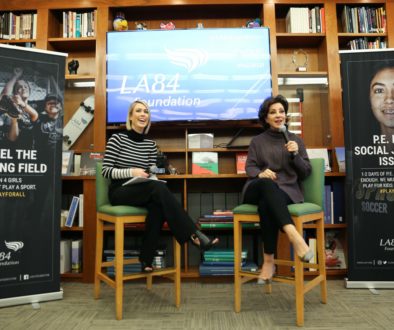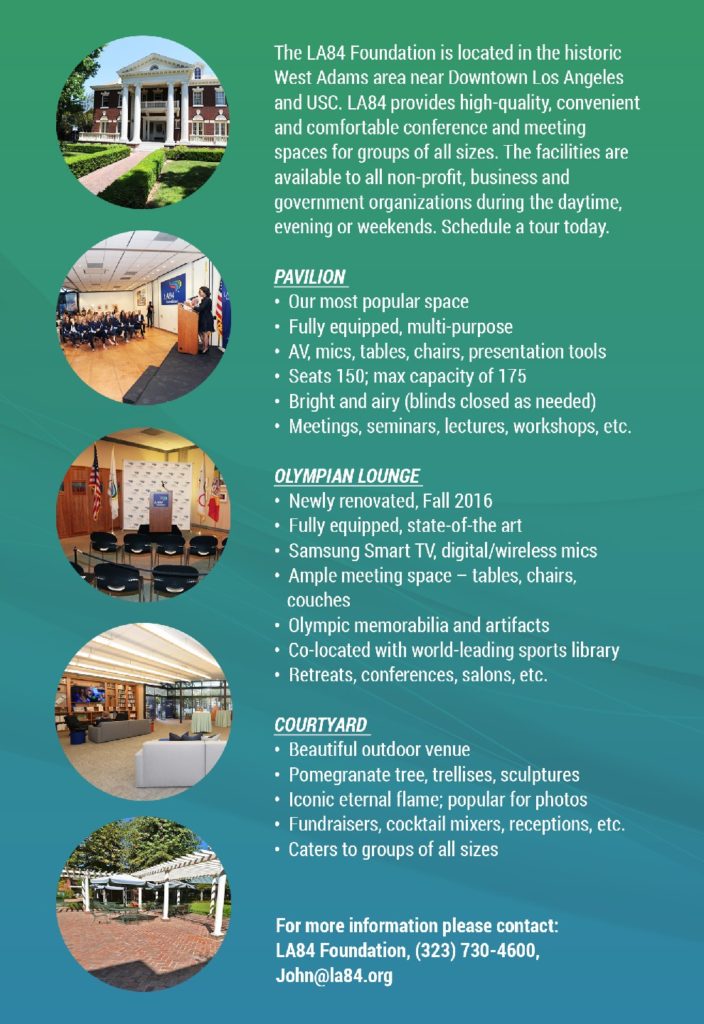SL Interview: Sociologist Reuben A. Buford May Talks Hoops, Hope and the American Dream
Reuben A. Buford May is a self-confessed basketball junkie. He played the sport as a young boy and, later, as a student-athlete at Aurora University. While working as a sociology professor at the University of Georgia, he spent years as an assistant coach with a high school basketball program located in a metro area outside of Atlanta. This experience led to his second book, “Living Through the Hoop: High School Basketball, Race, and the American Dream” (New York University Press; Amazon).
In “Living Through the Hoop,” May examines the appeal of basketball among youth at Northeast High School. (May has changed the actual name of the school, as well as the names of the students and other coaches in the book, for confidentiality purposes.) At the predominantly African-American school, May observes the players’ lives, on and off the court, and chronicles their triumphs and failures. And, as documented in the film “Hoop Dreams,” May notes that the promise of NBA riches and fame continues to exert a powerful and, at times, dangerous pull.
“Basketball offers young black men . . . a chance to hope for better in spite of their dismal starting point,” May writes. “These young men should no more be derided than any of us who invest our lives in long-shot dreams. After all, such dreams are conceived in a society that says to all, ‘you all can achieve whatever you want if you work for it.’ The sad reality is that young black men continue to be disproportionately blocked from achieving alternatives to hoop dreams.”
Part memoir, part ethnography, “Living Through the Hoop” was the co-winner of the Book of the Year award from the Association of Humanist Sociology.
May is a professor of sociology at Texas A&M University. Currently, he is a fellow at the W.E.B. Du Bois Institute for African and African American Research at Harvard University.
SportsLetter recently spoke with Professor May by phone.
— David Davis
SportsLetter: How much time did you spend researching and writing “Living Through the Hoop”?
Reuben May: I was involved with the basketball program for seven years as an assistant coach. In terms of doing the actual research on the book, it was over a three-year period of time. I worked with the boys probably nine-ten months out of the year, six-seven days a week.
SL: What was your role as assistant coach on the team?
RM: I was in charge of the substitution patterns on the team. This was a unique opportunity in that I had a lot of influence on the team.
SL: Why did you choose to write about basketball?
RM: It’s essentially a personal interest. I didn’t coach basketball to write the book. I wrote the book because, in coaching basketball, I began to see a different perspective about young men and their athletic dreams. I was struck by how many people have inaccurate thoughts about their chances, or prospects, of becoming athletes at big-time universities and beyond.
Think about the movie “Hoop Dreams.” The two young men in the film were pegged and sought after by meat-market guys who were agents that ran between the coaches and facilitated getting the top talent. The young men that I worked with at Northeast were average athletes, and yet they had the same kind of desire of success through sports as the kids in “Hoop Dreams.” That says a lot. Even at the college level – and this happened both with black and white athletes – a lot of the young men from Northeast who enrolled at the University of Georgia thought they could just walk on and make the team.
SL: What did you hope to find out through your research?
RM: One of the things I wanted to understand was what motivated these young men to pursue dreams that were completely unrealistic. We would expect them to have a clear understanding of their limitations for success in athletics – given the sheer number of people who play the game, given the fact that they were under-sized and had less exposure than other programs.
What I discovered were these things that, knitted together, encouraged them and motivated them, and gave them the perspective that athletics was a viable way of attaining social mobility. Writing the book and experiencing the lives of the young men gave clarity to me about how they can see blocked opportunity in one direction, but still make choices that are rational in the context of where their lives are at. What they’re doing makes sense if you look at it from where they’re standing.
SL: How would you describe Northeast, both the neighborhood and the high school?
RM: The Northeast neighborhood is a diverse community. But like most urban communities, the high school is located next to housing projects. In general, it’s a typical urban high school, with high populations of underprivileged minority students. A great proportionate of the African-Americans there were from the poor neighborhoods directly around the high school. Many of the white and middle-class people in area took their children and put them in private schools.
SL: How did the relationships you developed with the coaching staff and the players affect your research?
RM: I try to write openly and honestly about how, in our everyday interactions, we establish relationships and that these have consequences that shape our own thinking. I thought that my experience, and the telling of that experience, was enhanced with regard to the relationships I had established. They helped me to tell the story better.
I never felt there was any particular tension where I couldn’t be me or that it would cost me with regard to the research and writing of the book. One of the criticisms of the initial version of the book that I sent in for review was that they could tell that I thought very highly of Coach Benson. I wasn’t afraid to share that because I could see that there was a method to his madness.
SL: Why did you decide to use pseudonyms throughout the book?
RM: A lot of the guys wanted to be identified, but a few of the guys have gotten into trouble and some have done some not-nice things. They didn’t want to be identified and they shouldn’t have been identified. There was no way to do it halfway: I couldn’t identify some of the guys and not others.
SL: Northeast’s basketball program operated with a no-cut policy. Why did Coach Benson decide to adopt that policy?
RM: He was very much aware of the neighborhoods from which the young men came. He had a clear understanding that, for many of them, if they did not participate in some activity they would be lost to the streets. We had 25 guys on the team, which is ten more than any other team, but there was a point to it. Coach Benson knew and understood what was out there for these young men if they didn’t have basketball.
SL: Was it difficult with 25 guys on the team?
RM: You always had to manage people’s expectations. The young men had expectations about their playing time and the parents had expectations that their child would get a scholarship if they got big minutes and could be seen [by college recruiters]. So, there was a constant tension on the team. Sometimes, when guys wouldn’t dress for the games and would be carrying the bags, they’d get into a funk. They’d have an attitude because they were frustrated. That was the most difficult part for me in coaching. Before each game, I’d pass out the uniforms and get to the last five guys who wouldn’t dress. Every game, you had different guys who had the anticipation of playing, only to be disappointed by the fact that they would not be used.
SL: At the same time, Coach Benson comes across as willing to do anything to win. Was there a “win-at-all-costs” mentality at Northeast?
RM: No, it was win-at-all-costs but not beyond the bounds of regular competition. There was never any instructions to hurt a guy or to cheat or anything like that. It was more of an attitude: stand up, be competitive, be aggressive.
SL: You write about the dangers that players on the team face, including drugs and alcohol and delinquency. Were the players able to avoid what you describe as “the call of the streets”?
RM: For the most part, yes. When the young men are playing on the team, then they’re away from the troubles. During the season, they had mandatory study hall after class, then practice. By the time they’re done with practice, they’re too tired to be in trouble. It worked. Those people that left the program, I saw clearly that they tailed off and got pulled into the streets.
SL: You write about the double-edged sword of “Hoop Dreams.” What do you mean by that?
RM: The double-edged sword is, you give people hope to pursue athletics. The downside is, they focus too much on sports and don’t develop alternatives. They don’t build up other skills and there’s no backup plan. So, if they fail with athletics, then there’s nothing to fall back on.
The main goal with Coach Benson’s approach was to get them away from where they were. By keeping the young men from the dangers of the streets and by making them go to study hall, they could experience alternatives. That worked for a lot of young men.
SL: How did you see your role in this, both as coach and as sociologist?
RM: As a sociologist, I clearly understood the long-shot odds these young men faced. Yet, as a coach, I participated in this idea of giving young men hope through sports, of using basketball to motivate them. I began to reflect on this after one of the players, Calvin Cody, took his own life. I had invested so much in him being a basketball player and had encouraged him to play basketball. When he couldn’t play any longer, he took his own life. In some way I had to think I was responsible for this young man’s difficulties because everything he believed in and hoped for was in basketball. It took my wife to bring clarity for me: given where he came from, and what he had to deal with, giving him some hope through basketball was a positive thing to do.
SL: Calvin Cody took his own life after he left high school. Do you know what happened?
RM: He was having some success after high school, playing ball at a small college in Georgia. Then, he was derailed and, after that, he took his life. Knowing him, I would say that he would never do such a thing. But then we got the phone call. It’s a mystery, and that’s the troubling part in terms of closure.
SL: Did all of the players at Northeast have an unrealistic view of their ability and their future in basketball?
RM: More than just those players have an unrealistic view of their ability. Most of us have a lofty self-image, in that we think we’re better than we are. So, I don’t think it was unusual that they possessed that. But this perception comes out more negatively in the case of sports because, if you believe that and you invest this time and energy in it, then ultimately when you fail there’s nothing else that can make up for it. When that reality kicks in determines how you change the direction of your course.
SL: How did the players at Northeast perceive their participation in basketball: as recreation, as a status symbol, or as a means for mobility?
RM: I think it was all of the above. For particular players, it was one thing more than others. Guys that didn’t play very much were happy to have had the opportunity to participate. Being together with other young men was a positive for them. Other players were trying to create college opportunities in athletics, and so this was something they looked forward to in terms of proving themselves.
SL: What role does race play in the lives of the athletes you observed at Northeast?
RM: It was interesting because they played in basically an all-white league. Their perception of their ability in comparison to white athletes was racialized to the extent that many of them said, “Oh, well, we’re supposed to be better.” Interestingly, those who had played for a few years understood that many of the white athletes they were competing with were comparable athletes. These young men developed a different view of the role of race in sports. They basically debunked the stereotypes themselves, even though they were constantly receiving affirmation that basketball is a black man’s game.
SL: Did you feel that race affected their decisions regarding basketball?
RM: The imagery that a lot of young black males receive is that this particular avenue — sports — is a heralded, high-status way of achieving social mobility. There is nothing explicitly racialized about the experience. But the overall emphasis for young black males, in terms of imagery, is on sports. That’s where we have our entertainers and our celebrities. So, it’s this intuitive thing to gravitate to and identify with. They’re not shown, or they’re not able to develop an affinity for, other alternatives. The assumptions that many people have about black males -– and what they can or cannot do — already lock them into the track for athletics or nothing. So, the young men are making rational, viable choices in their communities based upon what they know.
There’s been a lot of talk about the natural black athlete, that black athletes have inherent talent and don’t have to work hard. The young men I coached were like all the ones I saw in the past who’ve had any success. They worked at it. They know that there’s work involved in it. It’s just that, they don’t know how to do any other kind of work.
SL: How can there be better balance in this, so that sports can play a positive role in the lives of youth?
RM: What we need to do is to think about how we might create alternatives they can do sooner. If someone says, “I want to be a basketball player,” we can say, “Okay, fine, you can do that and here are also some alternatives.” As coaches in schools and as people who deal with young athletes, we need to think about alternatives and how to structure them so that the kids can see that there is something else they can do beyond basketball.
SL: What are some of those alternatives?
RM: I think it has a lot to do with how we think about education. We need to improve the education at schools and create better opportunities at these schools. That creates a different kind of dynamic about what the young men are doing. In other words, I don’t think this is a problem for young African-American males who compete in basketball at suburban schools because they’re learning other skills. Whereas at places like Northeast, people play basketball because that is what they can do, it’s easy for them to do this, it’s a thing that is supported. It’s presumed in many cases.
SL: The book is about your experience coaching high school basketball, as opposed to AAU basketball. How has AAU ball changed the nature of youth basketball?
RM: AAU teams have been able to capture, or draw, some of the best high-school talent in one collection. If you’re a college coach and you want to see the best players, you just have to go to the various AAU tournaments. That draws attention away from the importance of the high school programs. The downside is, the commitment that’s necessary to build chemistry at the high school level is lost. Your star players are away, bettering their own careers. And, if they’re not humble, you have to deal with this mentality about them being on top. The other downside is, because people know that AAU ball is the way to be seen, you have a lot of people creating teams who don’t have the resources or ability to coach youth and are just in it for themselves.
SL: What unique pressures do high school coaches face today?
RM: There’s a great emphasis placed on winning, on having success. There’s something about school spirit – the morale of the school is high when teams are doing well – and there’s something about the economics that are generated by successful teams. These things are important because they’re part of the community building that also goes on. I think there’s a great deal of pressure placed on people to win, and most coaches recognize that they’re replaceable.
SL: You’ve coached both boys and girls basketball teams. In your experience, do boys and girls approach sports differently?
RM: I think that the boys and the girls do approach competitive sports differently. For many of the young men that I coached, their identity was grounded in their athletic ability. They viewed sports as a source of masculinity and what it means to be a man. For the young ladies I coached, their identity was based not just on their participation in sport, but other things about themselves. Basketball was something they competed in, but it didn’t make up the whole of their identity.
SL: Which writers have influenced you in terms of writing about sports and sociology?
RM: Of course, work by Harry Edwards with respect to his perceptions and observations about how black athletes are maintained and used. There’s also work by Billy Hawkins, at the University of Georgia, about the dynamics of athletic programs at colleges. [Editor’s note: Edwards is the author of, among others, “Sociology of Sport.” Hawkins is the author of “The New Plantation: The Internal Colonization of Black Student-Athletes on Predominantly White NCAA Institutions.”]




